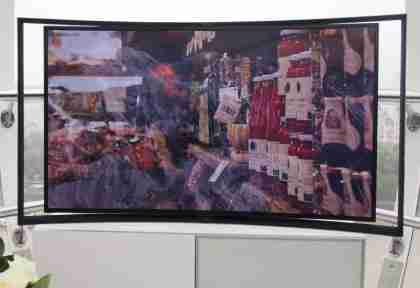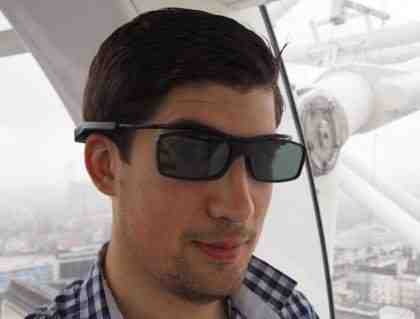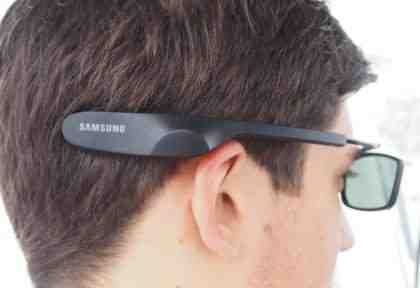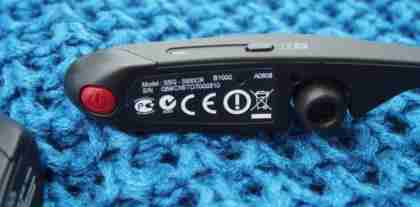Samsung's S9C curved OLED TV first made an appearance at this year's CES show in Las Vegas, but it has taken until now for it to arrive in the UK. We got some hands-on time with one on the London Eye today, in order to try out one of it's less talked about features - Multi View.

Two pictures at once, made possible with Multi View - a mountain on the left and pasta sauce on the right
Multi View takes the same concept used to create 3D video with active shutter glasses, but instead lets the TV display two sources at once. We saw something similar with LG's 47LS860W , which could take a split-screen video game and stretch it across the whole display if both players wore passive glasses, but Multi View doesn't halve the screen resolution and can be used for multiple sources, rather than just one.

They are light and comfortable, but you can't look cool in a pair of 3D glasses
Each pair of 3D glasses has a button which switches between the two feeds, letting you swap from one TV channel to another or from a games console to a Blu-ray player, without disrupting other viewers. The 3D glasses have four separate synchronisation channels, meaning you aren't restricted to 2D content - if you wanted, you could have two different 3D videos running at the same time. You get a Full HD picture and you also get stereo sound through the pair of in-ear headphones built into the headset arms.


They are a little chunkier than most 3D glasses, but the built-in earphones (which flick out on short leads to go in your ears) more than make up for it
During our demo time with Multi view, we were impressed with how flicker-free the picture was - it was difficult to tell you were watching through a pair of glasses. Unsurprisingly colour takes a small hit, but because the underlying technology creates such vibrant colours anyway this was less apparent than on every other active 3D TV we've tried. Switching between inputs was instant too, with no loss of synchronisation as the glasses changed from one input to another.
We aren't sure whether we'd want to watch something while our significant other watched something completely different, as it feels rather anti-social, but there's no doubt that it would settle arguments when you can't decide what to watch.
It's difficult to make out the curve when sat directly in front of the S9C
The S9C itself is a 55in, Full HD 1,920x,1080 TV with a steady curve designed to fill your field of vision. The screen is mounted in a polished metal frame, which despite looking like it would let you swivel the set is locked firmly in place. The screen itself curves outwards to better fill your vision, although unless you're sat less than a few feet away we didn't feel it made any significant difference to the experience. Samsung might be trying to replicate the cinema, but we don't think that's possible in a 55in TV.
The polished metal finish gives the S9C a seriously premium appearance
With no VESA wall-mounting points on the back of the set you won't be able to hang it, and because the speakers are built into the frame you can't separate the two either. However, this design has let Samsung add front-firing speaker drivers that point directly at the viewer rather than backwards at a wall or TV cabinet. We weren't able to fully test the sound during our short trip around the London Eye, but it stands to reason that they won't be able to compete with a full surround sound system.
The speakers are built into the lower part of the TV frame, firing forward for clearer sound
The S9C uses OLED technology, meaning every single pixel is made from organic LEDs which emit their own light. From what we could see, it appears to be using a full RGB OLED panel, meaning it has a red, green and blue sub-pixel for every single pixel. This is a step above the PenTile displays found in Samsung's Galaxy S4 smartphone, which only has two sub-pixels per 'pixel'.
The RGB OLED panel creates astonishingly vibrant colours and some of the deepest blacks we've seen
Because OLEDs emit their own light, there's no need for a backlight, which makes the S9C an incredibly thin TV. It also means that black response is outstanding, displaying the deepest dark tones next to incredibly bright whites. Motion, too, was impeccable. There was absolutely no sign of judder or blur, even during the fast-moving demo footage of skiers tackling a challenging mountain course.
The breakout box keeps the TV as slim as possible, and all your cables out of sight - click to enlarge
In order to keep the TV as thin as possible, Samsung has moved all the inputs and processing to a separate breakout box that can be hidden out of sight. It connects to the set using a proprietary cable that we're told has enough bandwidth to display an 8K image - more than enough for multiple HDMI 1.4 inputs. Because it also contains all the image processing hardware, it could technically be upgraded in the same way as Samsung's Evolution Kit, adding faster processing or even support for HDMI 2.0 inputs in the future.
Stepping around the back reveals the full effect of the S9C's curve
The S9C should be arriving in John Lewis and Samsung's Experience store shortly, although you'll have to pay a significant £6999 to bring one home. Fingers crossed we'll be bringing you a more detailed review in the coming weeks.
Seth Barton contributed to this article












